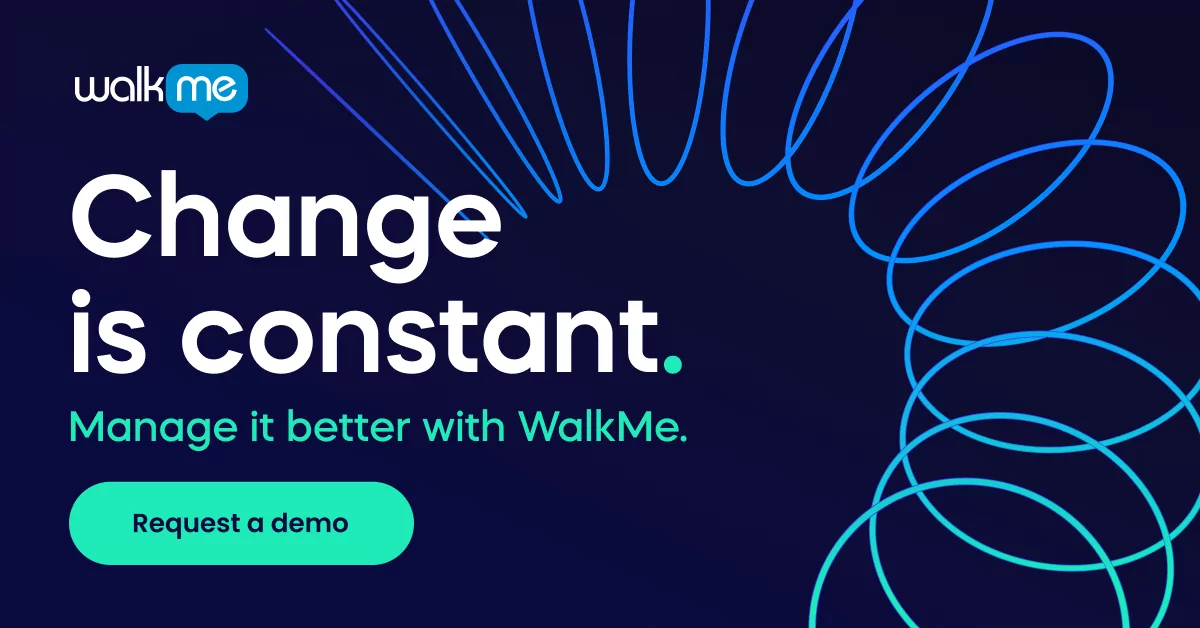Multimodal learning encompasses diverse instructional methods integrating visual, auditory, and kinesthetic sensory channels to enhance employee learning and development (L&D).
In an era where digitalization is rapidly shaping the modern workforce, HR leaders are recognizing the pivotal role of multimodal learning in fostering effective training and development programs.
Employees seeking to enhance knowledge and skills development in professional environments find value in interactive group settings. A Statista survey on global workplace learning preferences showed collaborative classroom learning was popular among 42% of respondents.
This article explores strategies and real-world examples tailored for HR leaders seeking to optimize employee training through multimodal approaches while addressing the changing needs of the contemporary workplace.
From harnessing the power of multimedia to incorporating interactive elements, by the end of the article, readers will understand the potential of multimodal learning, helping HR leaders to affect change and elevate their organization’s learning culture.
What is multimodal learning?
Multimodal learning is an approach that integrates various learning methods that enhance employee development and overall comprehension. It combines visual, auditory, and interactive elements that accommodate individuals learning styles.
This approach recognizes that individuals absorb information uniquely and typically involves watching a video, listening to a lecture, engaging in hands-on activities, reading written content, or participating in any L&D activities that foster a richer educational experience.
A multimodal experience across learning environments makes education more engaging and accessible for all Involved. It fast-tracks the learners’ ability to absorb and retain information and enables leaders to use varied methods to increase workplace talent.
Why is multimodal learning important?
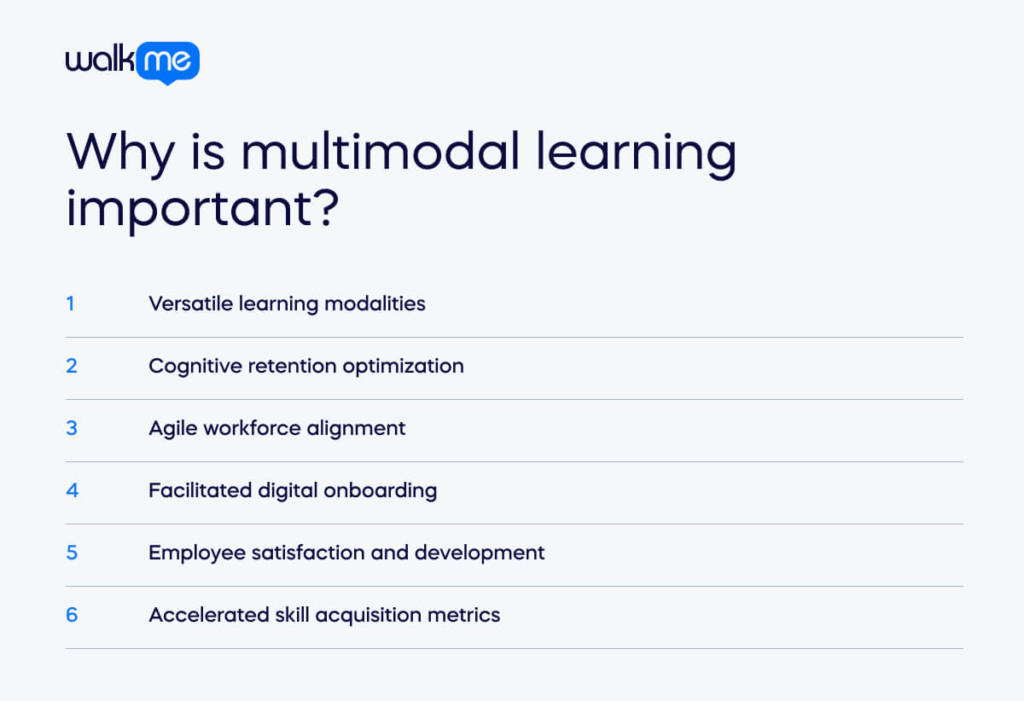
HR leaders leverage multimodal learning as their secret weapon in the corporate learning playbook.
Weaving in diverse approaches turbocharges information processing, fast-tracks digital adaptation, and hones advanced skills. Beyond being a mere educational resource, multimodal learning marks the intersection of strategy and organizational excellence, ushering in a transformative era in workforce management.
Let’s take a closer look at why multimodal learning is important:
- Versatile learning modalities: Multimodal learning systematically accommodates diverse cognitive preferences, encompassing visual, auditory, and kinesthetic modalities, optimizing comprehension across the employee spectrum.
- Cognitive retention optimization: Capitalizing on the cognitive psychology of information processing, multimodal learning strategically employs varied sensory inputs, enhancing memory consolidation and retrieval, ultimately elevating the efficacy of corporate training initiatives.
- Agile workforce alignment: In the contemporary corporate landscape, characterized by rapid technological advancements, multimodal learning ensures alignment with the dynamic demands of a tech-driven workforce, positioning HR leaders to navigate and facilitate seamless adaptation.
- Facilitated digital onboarding: For HR leaders at the helm of digital transformation, multimodal learning is a strategic enabler. It expedites comprehensive onboarding to digital platforms and processes, fosters proficiency, and reduces transition periods.
- Employee satisfaction and development: Beyond skill acquisition, integrating diverse learning methods in multimodal approaches reinforces a commitment to employee development, cultivating a positive organizational culture and bolstering overall job satisfaction.
- Accelerated skill acquisition metrics: The deliberate inclusion of visual, auditory, and kinesthetic elements in multimodal learning expedites the acquisition of new skills, translating into measurable performance enhancements and heightened productivity benchmarks.
What are the different types of multimodal learning?
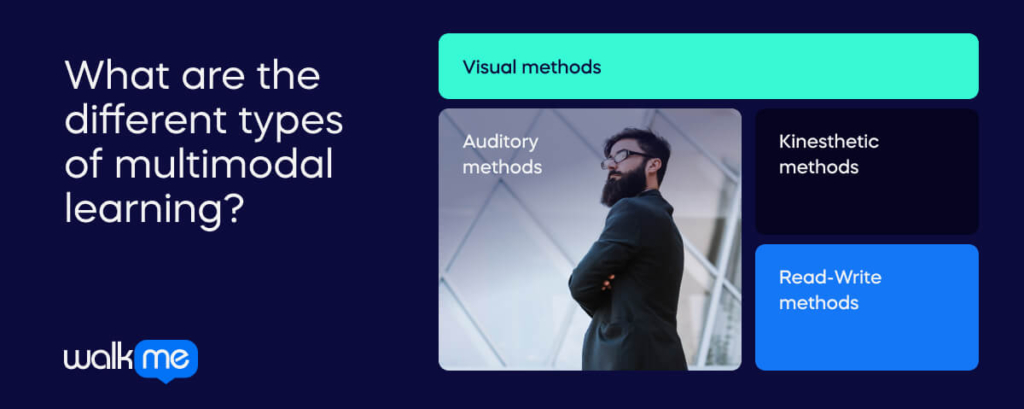
For HR leaders, understanding the different ways people learn is key.
It helps tailor training to suit everyone’s style—whether it’s visual, auditory, kinesthetic, or read-write. This smart approach boosts engagement, memory, and team growth in corporate environments subject to constant change.
Let’s take a closer look at the different multimodal learning styles:
- Visual methods in multimodal learning
Visual methods found in multimodal learning involve the integration of visual stimuli to enhance understanding. This encompasses graphical representations, charts, diagrams, and other visual aids.
Presenting information in a visually appealing format allows learners to grasp complex concepts more effectively. Visual learning methods cater to individuals who process information best through images and spatial arrangements.
- Auditory methods in multimodal learning
Auditory methods for employee L&D center on integrating sound elements into the learning process. This can include lectures, podcasts, discussions, and other auditory stimuli.
This method proves highly effective for individuals who primarily thrive on verbal communication. This allows HR leaders to tailor the subject matter in a way learners can best comprehend.
- Kinesthetic methods in multimodal learning
Kinesthetic learning methods involve enhancing learning capabilities through hands-on experiences and physical activities. HR leaders should incorporate experiential learning methods to cater to these learners. This can range from simulations and role-playing exercises to interactive labs and real-world activities.
Kinesthetic learners benefit from actively engaging with material, enabling them to better internalize and apply knowledge.
This hands-on approach will create a deeper understanding of concepts and is particularly effective in physical skill-based training scenarios.
- Read-Write methods in multimodal learning
Read-write learning modes focus on traditional text-based learning, which includes reading, writing, and literacy activities. This modality caters to individuals who thrive in a written environment and work best through reading and expressing ideas through writing.
Incorporating read-write elements ensures that textual learners can access and process information in a way that works for them. HR leaders can deploy L&D initiatives with read-write functionalities, empowering employees to actively engage with the content through note-taking, discussions, and collaborative projects.
Combining multimodal learning strategies
Multimodal learning strategies can combine two or more methods to create a comprehensive learning experience for the entire workforce. For example, a training program might incorporate visual aids alongside auditory explanations, accommodating both visual and auditory learners.
HR leaders can combine multimodal methods in L&D programs by incorporating a variety of content delivery formats for employee development. For instance:
- Blended learning modules: Develop training modules that blend written content for textual learners, visual aids (infographics, charts, or videos) for visual learners, and recorded lectures or podcasts for auditory learners.
- Interactive workshops: Conduct interactive workshops that include hands-on activities, discussions, and simulations. This approach engages kinesthetic learners while providing auditory and visual learners opportunities to participate actively.
- Online platforms with diverse content: Utilize online learning platforms that offer a mix of multimedia content. This can include text-based materials, instructional videos, audio explanations, and interactive quizzes or assessments catering to various learning preferences.
- Collaborative learning environments: Foster employee collaboration through group projects, forums, or online discussions. This promotes social learning and accommodates those who benefit from interactive and social learning experiences.
- Personalized learning paths: Allow employees to choose or personalize their learning paths based on their preferences. Provide a menu of resources, such as articles, videos, and interactive modules, allowing individuals to select content that aligns with their preferred learning style.
By intentionally incorporating these strategies, HR leaders can create a learning environment that maximizes the benefits of each modality, ensuring a holistic approach that reaches a broader spectrum of learning styles for all employees.
How to create a multimodal learning strategy
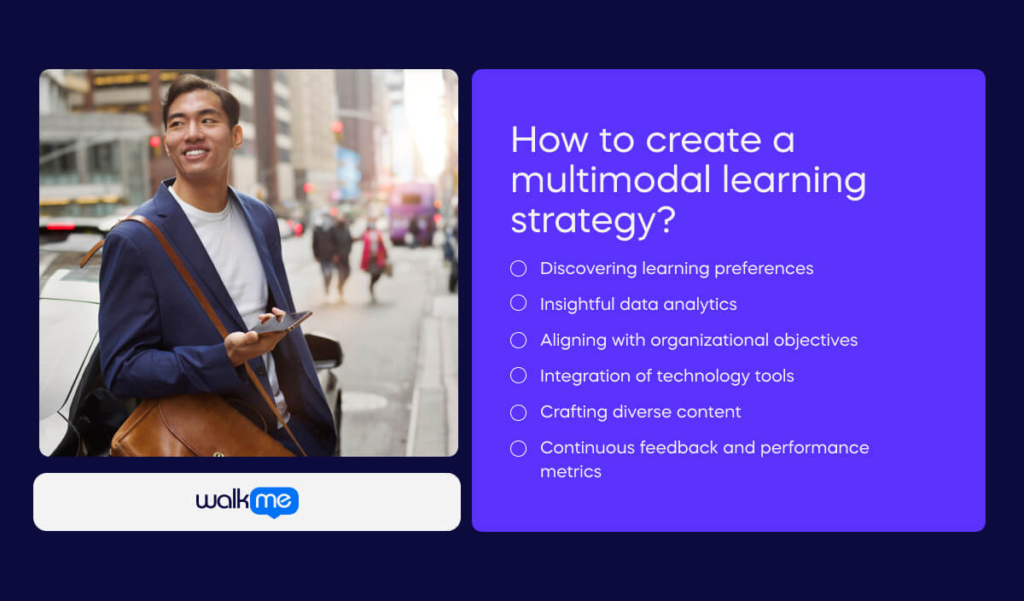
Embracing a multimodal learning strategy is essential for HR leaders as it enables them to address the diverse learning preferences of employees. This approach is gaining popularity, especially given the significant industry transformations.
Recognizing the value of adaptable and versatile learning methods can boost engagement, enhance skill acquisition, and align training initiatives with organizational goals.
Ultimately, it produces a dynamic learning culture, ensuring employee development and adaptability in the modern workplace.
Let’s take a closer look at how to build a multimodal learning strategy:
Step 1: Discovering learning preferences
Start on the multimodal learning journey by uncovering employees’ preferred learning styles. Use surveys, interviews, and observations to reveal individual inclinations toward visual, auditory, kinesthetic, or read-write modalities.
This step provides a foundation for understanding the diverse learning landscape within the workforce and will paint a nuanced picture of individual inclinations toward various modalities.
Step 2: Insightful data analytics
Utilize data analytics to extract meaningful patterns from the collected information.
The goal is to evaluate which methods contribute to accelerating employees’ learning curves and which don’t. This analytical approach gives HR leaders actionable insights, supporting informed decisions when shaping a tailored learning strategy.
Become adept at data analytics to extract actionable insights from learning style patterns. Use quantitative analysis to inform decision-making and tailor the multimodal learning strategy effectively.
Step 3: Aligning with organizational objectives
Next, the multimodal learning strategy should be harmonized with overarching organizational goals while identifying the critical skills and competencies required of employees to achieve these goals.
Tailor the approach to complement individual learning styles while strategically aligning with the company’s broader objectives. This step ensures a cohesive integration of learning initiatives with the organizational roadmap.
Step 4: Integration of technology tools
Diversify content delivery by incorporating essential technologies, such as learning management systems (LMS) and interactive digital adoption platforms (DAPs).
This technological integration enhances scalability, accessibility, and engagement. Embracing these tools ensures HR leaders improve the effectiveness and relevance of the multimodal learning experience.
Step 5: Crafting diverse content
Develop and curate content that caters to various learning styles. Utilize infographics, videos, charts, podcasts, interactive simulations, and textual content.
This diverse content approach ensures that each learning modality is addressed, providing a comprehensive learning experience that resonates with the workforce’s varied preferences.
Step 6: Continuous feedback and performance metrics
Establish a continuous feedback loop to gather real-time insights into the effectiveness of the multimodal strategy. Encourage employees to provide feedback for dynamic adjustments.
Simultaneously, define key performance indicators (KPIs) to assess learning outcomes, skill acquisition, and workforce development against predetermined benchmarks and milestones. This dual approach ensures ongoing refinement and optimization of the multimodal learning strategy.
Real-world multimodal strategy examples
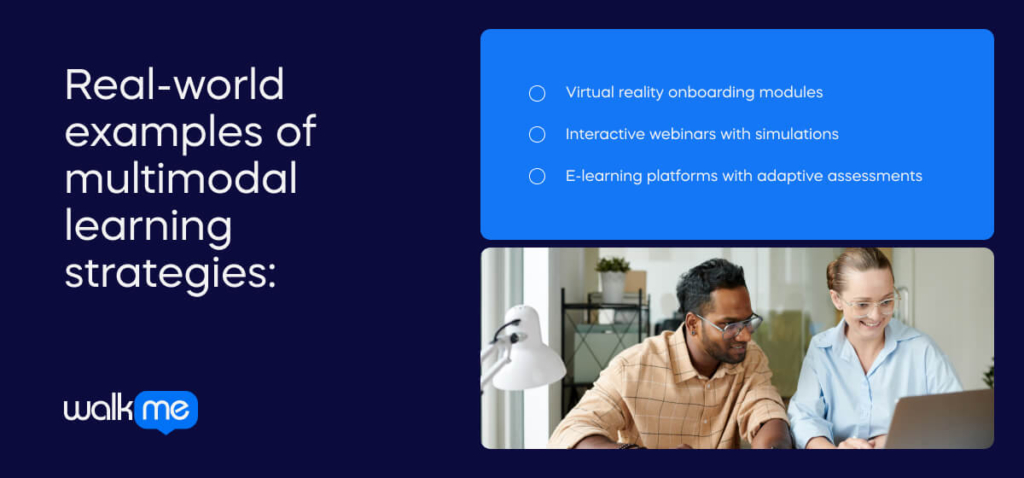
Real-world multimodal learning strategy examples provide tangible insights for HR leaders, illustrating how to tailor training programs to diverse learning styles.
Understanding these examples enables HR leaders to make informed decisions, nurture a dynamic learning culture aligned with organizational goals, and engage employees through various modalities.
Let’s take a closer look at some real-world examples of multimodal learning strategies:
- Virtual reality onboarding modules: Implementing virtual reality (VR) onboarding modules allows HR leaders to create immersive experiences for new hires. Employees can navigate virtual workplace scenarios by combining visual and interactive elements, fostering a deeper understanding of company processes and culture.
- Interactive webinars with simulations: Hosting interactive webinars that incorporate simulations caters to various learning styles. HR leaders can blend auditory elements through live discussions, visual aids, presentations, and kinesthetic engagement with hands-on simulations. This approach ensures a comprehensive learning experience for diverse audiences.
- E-learning platforms with adaptive assessments: Utilizing e-learning platforms featuring adaptive assessments tailors the learning experience. These platforms assess individual strengths and weaknesses, adjusting the content delivery to suit different learning styles. HR leaders benefit from data analytics, gaining insights into employee performance and optimizing training programs accordingly.
Gamification and multimodal learning
In corporate training, gamification is a powerful tool that, when strategically integrated, enhances the effectiveness of multimodal learning.
Gamification involves incorporating game elements, such as competition, challenges, and rewards, into non-game contexts. Coupled with a multimodal learning approach, it offers HR leaders a dynamic strategy to engage and educate employees across diverse learning preferences.
Let’s take a closer look at gamification and multimodal learning in more detail:
Engagement across modalities
Gamification engages employees visually, kinesthetically, and even auditorily, depending on the design. Visual elements like graphics and animations appeal to visual learners, interactive challenges cater to kinesthetic learners, and sound effects or voiceovers accommodate auditory learners. HR leaders can leverage this multifaceted approach to ensure the gamified content resonates with a broad spectrum of employees.
Skill reinforcement through challenges
Incorporating challenges within gamified modules allows HR leaders to reinforce skills in a way that aligns with different learning styles. Whether problem-solving scenarios, decision-making challenges, or interactive simulations, gamification will enable employees to apply knowledge practically and hands-only. This resonates particularly well with kinesthetic learners who thrive in interactive environments.
Progress tracking and feedback
Gamification seamlessly integrates with multimodal learning by providing real-time feedback and progress tracking. Visual progress bars, achievement badges, and auditory cues offer immediate feedback, keeping learners motivated. HR leaders can utilize this feature to address the read-write learning style, allowing employees to track their progress through written reports or reflective exercises.
Enhanced retention and adaptability
The competitive and rewarding nature of gamification enhances information retention. Whether through visual storytelling, interactive challenges, or auditory feedback, the multimodal aspects of gamification make learning memorable. HR leaders can capitalize on this by ensuring crucial information is embedded within gamified scenarios, fostering adaptability and quick recall in various work situations.
Measurable outcomes and continuous improvement
Gamification aligns seamlessly with key performance indicators (KPIs) to measure outcomes. HR leaders can track engagement levels, completion rates, and performance improvements, providing quantifiable data. This enables a continuous improvement cycle, allowing HR teams to refine and optimize multimodal learning strategies based on real-time feedback and demonstrated success in gamified elements.
Mastering multimodal learning: A blueprint for HR success
HR leaders maintain a strategic edge in the corporate world by investing in multimodal learning, a linchpin for successfully navigating change management and digital adoption.
As organizations embrace technology integration, tailored learning experiences become paramount. HR leaders astutely recognize that the power of multimodal learning lies in its ability to cater to diverse learning styles—visual, auditory, kinesthetic, or read-write.
This approach isn’t about acquiring skills but a deliberate effort to cultivate a culture of continuous improvement within the workforce. Beyond preparing employees for current challenges, the focus is building a resilient organizational culture that integrates learning, embraces change, and propels the enterprise toward sustained success.
Investing in multimodal learning goes beyond upskilling—creating an adaptable workforce is a strategic move. HR leaders foster an agile and responsive organizational culture by offering diverse learning opportunities.
In this paradigm, learning becomes not just a means to an end but a force that propels the organization forward, ensuring it remains agile and resilient amidst the complexities of ongoing digital transformations.
